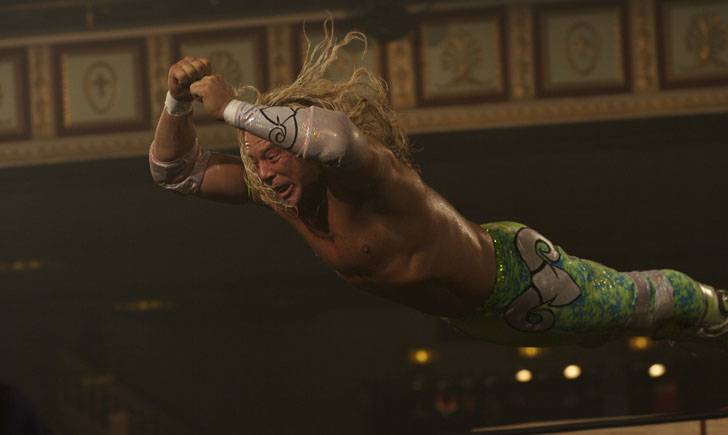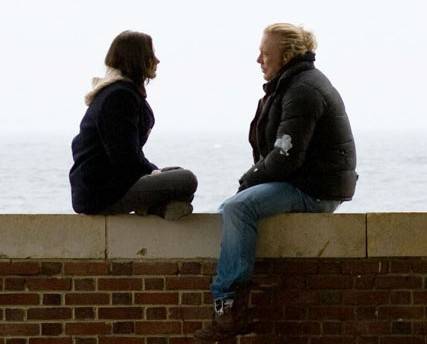
A good friend of mine called it one of the best movies he has ever seen. Another friend, a movie critic, called it the year’s best film. Hell, even Vince McMahon, the man who pulls the strings behind the real wrestling curtain, said he was touched by it. But I found The Wrestler to be, well, good but not great. Call me The Buzzkill.
The Wrestler’s storyline is relatively simple, maybe even too simple for WWF standards. Mickey Rourke plays Randy “The Ram” Robinson, an over-the-hill wrestler who is 20 years removed from his glory days in the league’s top circuit. In his heyday, The Ram battled The Ayatollah, a black man dressed as an Iranian Sheik (of course). In the real WWF, such a wrestler, aptly known as The Iron Sheik, wrestled during the mid-1980s and, just like his film counterpart, fiercely battled the one man strong enough to defend America’s honor. In real fake wrestling, that man was Sgt. Slaughter. In our movie, it’s The Ram.
The film’s allusions to the culture of modern professional wrestling don’t end there. The Wrestler is an accurate portrayal of the sport: from the drugs necessary to bulk up and the drugs needed to kill the pain, to the ridiculous, stereotyped characters, to the wrestlers’ loyalty to the sport and inability to let go. It’s this latter issue that drives the plotline. The Ram has never done anything but wrestle. Each time he steps into the ring —- which is now centered in an out-of-the-way American Legion hall instead of Madison Square Garden — he can still taste the success of his younger years when blood mixes with the salt of his sweat and slides into the corner of his mouth. So, The Ram spends his weekends headlining small-time, indie-circuit bills full of up-and-comers who admire the veteran. But life in the ring ain’t what it used to be. Like his elder statesmen peers who now sell their image of yesteryear at rinky-dink autograph sessions, The Ram’s body is breaking down, if not already broken. But his spirit, against the odds, continues to endure.
 Marisa Tomei, bared breasts and all, spends the better part of the movie, like The Ram, trying to remain “professional.” She’s a tattooed, washed-up stripper at a club The Ram frequents. We are to assume that Tomei’s character, Cassidy, is past her prime, although she truly looks far from it (of course). She is ridiculed by college kids who find her too matronly. And indeed, she is matronly in one sense: she has a nine-year-old kid and strips only because it pays the bills. Unlike The Ram, Cassidy wants out of her chosen profession, seeking a real job and a chance to move her kid to a better neighborhood. She sees the writing on the wall, and she aims to heed the advice. Moreover, she understands her role as a performer and doesn’t seek to blur her on-stage reality with her personal one.
Marisa Tomei, bared breasts and all, spends the better part of the movie, like The Ram, trying to remain “professional.” She’s a tattooed, washed-up stripper at a club The Ram frequents. We are to assume that Tomei’s character, Cassidy, is past her prime, although she truly looks far from it (of course). She is ridiculed by college kids who find her too matronly. And indeed, she is matronly in one sense: she has a nine-year-old kid and strips only because it pays the bills. Unlike The Ram, Cassidy wants out of her chosen profession, seeking a real job and a chance to move her kid to a better neighborhood. She sees the writing on the wall, and she aims to heed the advice. Moreover, she understands her role as a performer and doesn’t seek to blur her on-stage reality with her personal one.
The dynamic between Rourke and Tomei is engaging. Theirs is a humble love story that feels a bit rushed, but nonetheless authentic. Neither character possesses eloquence, a point that is driven home by straightforward dialogue and a script not short on awkward moments. The Ram tries to woo Cassidy by giving her his own rendition of a lapdance while Ratt’s “Round and Round” — the entire film is scored by ’80s pop-metal — blares over a jukebox. It’s the sort of scene that would typically earn either a cringe or a guffaw from viewers; but in this case, the forced clumsiness is in character. This is a guy, after all, who still makes an incredibly meager living by slamming his heavily-padded elbows into his palms, wrestles as himself when playing a 1980s-era Nintendo wrestling game, and can’t remember his lone daughter’s birthday.
 Oh yes, the estranged daughter, Stephanie, played by Evan Rachel Wood. Her sole purpose in the film is to drive home the point that The Ram is utterly alone, a social outcast who is so incapable of relating to the real world that he can’t even muster the courage to communicate with his daughter, whom he deserted when she was a young child. Her storyline is thrusted upon us with even less of an introduction than the romantic angle, and is really given short shrift. To complicate matters, Wood’s performance is lackluster, her character too cardboard-like.
Oh yes, the estranged daughter, Stephanie, played by Evan Rachel Wood. Her sole purpose in the film is to drive home the point that The Ram is utterly alone, a social outcast who is so incapable of relating to the real world that he can’t even muster the courage to communicate with his daughter, whom he deserted when she was a young child. Her storyline is thrusted upon us with even less of an introduction than the romantic angle, and is really given short shrift. To complicate matters, Wood’s performance is lackluster, her character too cardboard-like.
My main beef with this movie is not its bluntness or its sentimental ways. Nor is it the lack of a Hollywood ending (without giving much away, The Ram hits rock bottom, then sinks further — and this is all very believable). Writer Robert Siegel and director Darren Aronofsky did a good job seeing what storyline they do offer through to its logical conclusion. And Rourke, who really is dynamite, is ideally suited for such a comeback role. Where The Wrestler falls short is in the transparent plot’s lack of depth. It’s a character sketch stretched beyond its comfort zone. As such, the plot never gets in the way of Rourke’s brazen performance, which works to the actor’s benefit. But I could have done with a bit more meat — or muscle, if you prefer — on the bone. The plotline could have benefited from some performance-enhancing drugs.
Maybe I’m the exception to the rule, but having edited several books written by real wrestlers, I wasn’t taken aback by the beat downs these wrestlers enact on each other (although one scene, in particular, made me a bit nauseous). The film’s attempt to pull the curtain back to reveal the mechanism behind pro wrestling did little for me, because I’m already familiar with it. The Ram’s wrestling story, and to a lesser degree his personal story, is fairly commonplace in pro wrestling. Considering wrestlers are partaking in a sport with scripted outcomes, these guys do some seriously insane things to themselves to make a quick buck, then to stay on top, and finally to cope with the toll the sport exacts on them. Once removed from the spotlight, some will stop at nothing in their attempts to maintain a grasp on the sport, because they just don’t know how to assimilate back into society without the guise of spandex. There are bountiful examples of men in their forties, weekend warriors, still torturing themselves in the squared circle. Given this knowledge, the shock and awe that some viewers probably endured during this film had far less impact on me — which left me with the plot to cling to.
The main premise — that The Ram is stuck in a tormenting limbo — held my attention for only so long. The love story was a worthwhile diversion, but little more. This movie is more of a well-crafted snapshot, and I was hoping for a photo album. I kept waiting for the plot to thicken, for The Ram’s story to broaden beyond the more obvious themes, but it never did. I suppose in its failure to do so, The Wrestler keeps it real. After all, these are often uncomplicated men. But that’s where this film could benefit from learning a lesson from its subject matter: sometimes it’s best to step outside the bounds of reality. Or, at the very least, to think big.
——
The Wrestler is currently playing at Boardman’s Art Theatre through Feb. 12. It is also currently playing at the Savoy 16 and Carmike Beverly theaters.








